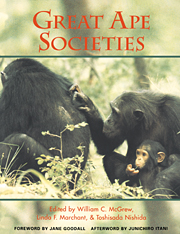Book contents
- Frontmatter
- Contents
- List of contributors
- Preface
- Foreword: conserving great apes
- Part I Apes overviewed
- Part II Social ecology
- Part III Social relations
- Part IV Minds
- 12 Conflict as negotiation
- 13 Language perceived: Paniscus branches out
- 14 Reciprocation in apes: from complex cognition to self-structuring
- 15 Chimpanzee intelligence in nature and in captivity: isomorphism of symbol use and tool use
- Part V Apes compared
- Part VI Modeling ourselves
- Afterword: a new milestone in great ape research
- Appendix: great ape study sites
- Index
15 - Chimpanzee intelligence in nature and in captivity: isomorphism of symbol use and tool use
Published online by Cambridge University Press: 04 August 2010
- Frontmatter
- Contents
- List of contributors
- Preface
- Foreword: conserving great apes
- Part I Apes overviewed
- Part II Social ecology
- Part III Social relations
- Part IV Minds
- 12 Conflict as negotiation
- 13 Language perceived: Paniscus branches out
- 14 Reciprocation in apes: from complex cognition to self-structuring
- 15 Chimpanzee intelligence in nature and in captivity: isomorphism of symbol use and tool use
- Part V Apes compared
- Part VI Modeling ourselves
- Afterword: a new milestone in great ape research
- Appendix: great ape study sites
- Index
Summary
INTRODUCTION
Chimpanzee intelligence can be studied from two very different points of view. One is the experimental analysis of the cognitive skills of captive chimpanzees. The other is the field observation of behavioral patterns in wild chimpanzees. This paper aims to form a new bridge between the two separate fields by presenting a synthesized view of chimpanzee intelligence through research in both the laboratory and the wild.
People have believed that human beings are a unique species (Sebeok & Umiker–Sebeok, 1980; Lieberman, 1991). In comparison with other animals, humans seem to have special features: language, tools, culture and so on. These human traits have been attributed to our species' unique intelligence based on a highly developed neocortex. Are we really so unique? If so, how and why has such a unique creature evolved? What is the ultimate difference between humans and other creatures? To answer these questions, one should look not only at humans but also at the species with whom we last shared a common ancestor in our evolutionary history. Chimpanzees are the most appropriate species, because they are the closest relative of humans.
My approach may be described as Comparative Cognitive Science (CCS). This new discipline aims to understand human cognition from an evolutionary perspective. The research method is characterized by the comparison of the performance of different species based on an unified objective scale.
- Type
- Chapter
- Information
- Great Ape Societies , pp. 196 - 210Publisher: Cambridge University PressPrint publication year: 1996
- 67
- Cited by

